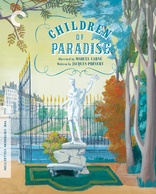Children of Paradise Blu-ray Movie
HomeChildren of Paradise Blu-ray Movie 
Les enfants du paradisCriterion | 1945 | 190 min | Not rated | Sep 18, 2012
Movie rating
8.2 | / 10 |
Blu-ray rating
| Users | 3.0 | |
| Reviewer | 3.0 | |
| Overall | 3.0 |
Overview
Children of Paradise (1945)
The theatrical life of a beautiful courtesan and the four men who love her.
Starring: Arletty, Jean-Louis Barrault, Pierre Brasseur, Pierre Renoir, María CasaresDirector: Marcel Carné
| Foreign | Uncertain |
| Drama | Uncertain |
| Romance | Uncertain |
Specifications
Video
Video codec: MPEG-4 AVC
Video resolution: 1080p
Aspect ratio: 1.37:1
Original aspect ratio: 1.37:1
Audio
French: LPCM Mono
Subtitles
English
Discs
50GB Blu-ray Disc
Two-disc set (2 BDs)
Playback
Region A (locked)
Review
Rating summary
| Movie | 5.0 | |
| Video | 2.5 | |
| Audio | 4.5 | |
| Extras | 4.5 | |
| Overall | 3.0 |
Children of Paradise Blu-ray Movie Review
Reviewed by Dr. Svet Atanasov September 7, 2012Marcel Carne's "Les enfants du paradis" a.k.a "Children of Paradise" (1945) arrives on Blu-ray courtesy of Criterion. The supplemental features on this release include original U.S. trailer for the film; short introduction by director Terry Gilliam; restoration demonstration; Julie Bonan's documentary film "Once Upon a Time: Children of Paradise"; visual essay by film writer Paul Ryan; audio commentaries by film scholars Brian Stonehill and Charles Affron; and more. The release also arrives with an illustrated booklet featuring an essay by film scholar Dudley Andrew and excerpts from a 1990 interview with director Marcel Carne. In French, with optional English subtitles for the main feature. Region-A "locked".
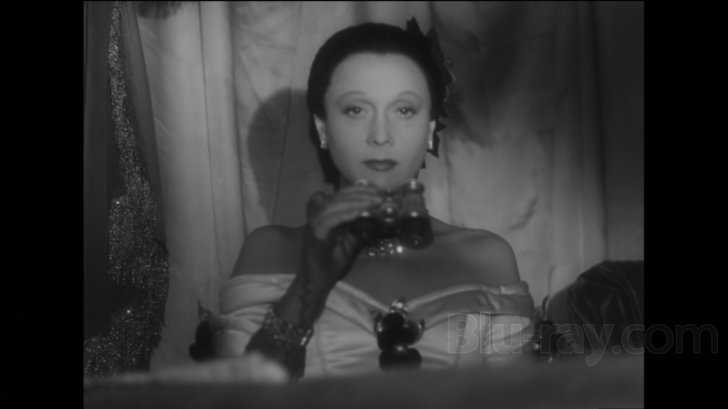
The wanted woman
The film opens up on the busy Boulevard du Crime where artists gather to impress the residents and guests of the French capital. There the beautiful courtesan Garance (played by the legendary Arletty, Flesh and the Woman) meets four men that would eventually compete for her love. The first is Frederick Lemaitre (Pierre Brasseur, Eyes Without a Face), a young and ambitious actor who dreams of becoming a star. He flirts with Garance, she flirts back and then he casually reveals to her that he is different. Garance smiles and then quickly disappears into the crowd.
The second man is Pierre-François Lacenaire (Marcel Herrand, Fanfan La Tulipe), an opportunist who would stop at nothing to accomplish his goals. Lacenaire is seriously disillusioned with society and incapable of tolerating its hypocrisy. This is why he often steals from those who have benefited the most from it.
While watching a play, Garance is accused of stealing the watch of a wealthy man. She is defended by the warmhearted mime Baptiste (Jean-Louis Barrault, La nuit de Varennes), who convinces everyone with a spectacular performance that Garance is innocent. Moved by his gentlemanly gesture, Garance gives the mime a flower and leaves Boulevard du Crime. As he watches her disappear, Baptiste realizes that he has fallen in love.
The fourth man is Count Edouard de Montray (Louis Salou, The Loves of Colette), a wealthy aristocrat with plenty of powerful friends. Like the men before him, the Count is struck by Garance’s beauty and immediately offers her patronage. Her response surprises him, but gives him hope that if he is persistent one day she could fall in love with him.
In the years to come, the four men would compete for Garance’s love. Some will be driven by their passion, others by their desire to prove that they could conquer any woman’s heart. Along the way, these men will discover who they truly are, and that love is like quicksand - because the deeper one falls in it, the harder it is to get out.
The film is divided into two rather large parts - Boulevard du Crime (Boulevard of Crime) and L’Homme Blanc (The Man in White). The first introduces the key characters, the relationships that will be followed closely and the important dilemmas some of these characters will struggle to resolve. The best allegories, one of the film’s greatest strengths, are also here -- justice and freedom are constant themes in the plays performed on Boulevard du Crime (remember that Children of Paradise was made during the German occupation of France during WWII and at the time French filmmakers were closely monitored by both Carlingue and Gestapo).
It is true that the film has a wonderful dreamy, unusually poetic atmosphere, but it never feels detached from reality. The characters and their emotions and feelings, triumphs and failures are completely authentic. In the second part, which begins a few years later, after each of the characters has experienced joy and sadness and their lives have headed in new directions, the fine line that separates life from stage drama is virtually invisible.
The script for Children of Paradise was written by the great Jacques Prévert, who worked with director Carne on a number of his best films, including Drole de Drame, Le Quai Des Brumes, Le jour se lève, and Les visiteurs du soir.
Note: In 1947, Children of Paradise earned an Oscar nomination for Best Writing, Original Screenplay (Jacques Prévert).
Children of Paradise Blu-ray Movie, Video Quality 

Presented in its original aspect ratio of 1.37:1, encoded with MPEG-4 AVC and granted a 1080p transfer, Marcel Carne's Children of Paradise arrives on Blu-ray courtesy of Criterion.
The following text appears inside the booklet provided with this Blu-ray disc:
"The digital restoration of Children of Paradise presented in this edition was performed by the legendary film company Pathe in 2011. Made by Pathe during the German occupation of France in World War II, Children of Paradise was shot on whatever types of scrap storck the filmmakers could their hands on. That original nitrate camera negative was the main source of the restoration, but it was in poor condition, with significant damage from scratches, dirt, and mold., as well as some tape residue from old splices, all of which had to be digitally removed. Also, in several instances, frames were missing from the original negative. These were reconstructed from multiple sources, including two 35mm nitrate fine-grain positives.
Before digitization, all elements were ultrasonically cleaned. The reels of the original camera negative and the selected parts of the fine-grain positives were then scanned at 4K resolution on an ARRISCAN film scanner at L'Immagine Ritrovata laboratory in Bologna, Italy. The 4K data was sent to Eclair Laboratories in Paris for reconstruction and picture restoration. Thousands of instances of dirt, debris, scratches, splices, warps, jitter, and flicker were manually removed using MTI, Image Systems, Da Vinci, and Cinnafilm restoration software. The poor state of certain shots could not be improved; characteristics of other shots, including soft focus and shadow effects in the theater scenes (typical of nineteenth-century stage lighting), were maintained in order to remain faithful to the film.
The original monaural soundtrack, restored by L.E. Diapason in Epinay-sur-Seine, France, is a patchwork of the best available sources, including a new preservation positive made from the original sound negative. Clicks and crackle were removed with a Cedar Cambridge workstation, while taking care to preserve the tone and texture of the original sound; remaining imperfections were removed manually.
Image restoration supervision: Xavier Loutreuil, Charlotte Quemy/Eclair, Epinay-sur-Seine, France.
Colorist: Isabelle Julien.
Scanning: L'Immagine Ritrovata, Cineteca di Bologna, Italy.
Sound restoration supervisor: Leon Rousseau/L.E. Diapason, Epinay-sur-Seine.
Blu-ray mastering: CMC, Malakoff, France; Radius60, Los Angeles."
____________________________________________________________
Criterion's Blu-ray release of Children of Paradise uses a high-definition transfer from Pathe's 2011 4K restoration of the film. Before the film's opening credits appear, Pathe have included the following information:
"Pathe presents the restored Les Enfants du paradis. This involved 4K digital scanning of the original nitrate negative and two nitrate fine grain masters. Refurbishing of elements and 4K scans were done at Immagine Ritrovata (Bologna). Reconstruction and picture restoration were done by Eclair Laboratories (Paris). Sound was restored from the original sound negative scan by L.E. Diapason (Paris). Theatre scenes include shadow effects typical of 19th century stage lighting. Other scenes respect the soft-focus effects of the cinematography."
While Pathe's restoration and reconstruction of this classic French film might well be very impressive, their high-definition transfer is disappointing. Traces of moderate to very heavy filtering corrections are easily noticeable throughout the entire film. Unsurprisingly, detail and clarity are seriously compromised. During many sequences colors and contrast also collapse, especially when light is restricted, and large blocks of gray become prominent. Because of the excessive filtering there is virtually no depth, while at times definition is so poor that it is absolutely impossible to see the fine details a 4K restoration should expose (see how in screencapture #20 the face of the man in the lower left corner is essentially filtered out). Additionally, Pathe's text description mentions the soft-focus effects of the original cinematography, but more often than not what is present here is an entirely different type of softness, one that is undoubtedly accomplished with the help of powerful digital tools (see screencaptures #10 and 11). Occasionally, there are even some halo effects/anomalies that pop up here and there (see screencapture #23). This being said, there are some portions of the film where one could get a basic idea of what could have been, mostly during the daylight sequences where there is an abundance of light and contrast levels are relatively stable (see screencapture #25), but even then often there is heavy smearing that tends to overwhelm the image. All in all, as far as I am concerned Children of Paradise's transition to Blu-ray is every bit as frustrating as Pathe's presentation of Jean-Pierre Melville's Le Samouraï. Obviously, there are other issues here, but the final result is undoubtedly disappointing. (Note: This is a Region-A "locked" Blu-ray disc. Therefore, you must have a native Region-A or Region-Free PS3 or SA in order to access its content).
Children of Paradise Blu-ray Movie, Audio Quality 
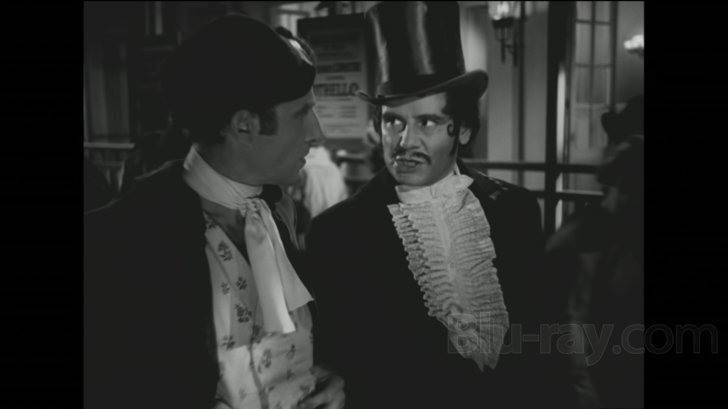
There is only one audio track on this release: French LPCM 1.0. For the record, Criterion have provided optional English subtitles for the main feature.
Generally speaking, the sound is stable and well rounded. Hiss and other background heavy noise have been eliminated as best as possible. There are no serious distortions or audio dropouts out either. This being said, overall dynamic activity is quite limited. The English translation is very good.
Children of Paradise Blu-ray Movie, Special Features and Extras 
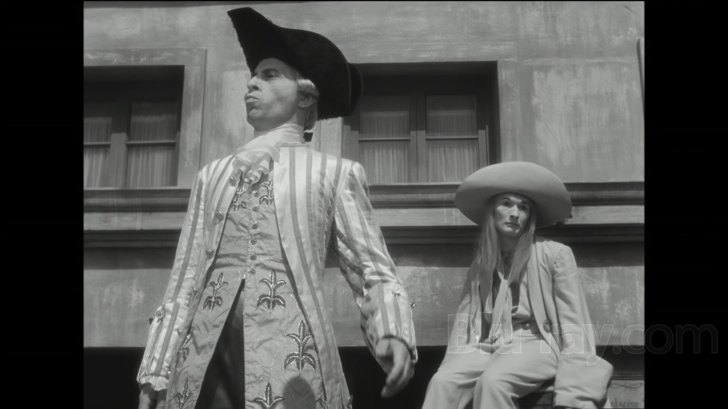
Note: All of the supplemental features are placed on a second BD-25 disc.
- Introduction - a short introduction to Children of Paradise by director Terry Gilliam. The introduction was recorded by Criterion in 1999. In English, not subtitled. (6 min, 1080i).
- Restoration Demonstration - a short demonstration for Pathe's 4K restoration of Children of Paradise. (5 min, 1080p).
- U.S. Trailer - original U.S. theatrical trailer for Children of Paradise. In English, not subtitled. (4 min, 1080i).
- Once Upon a Time: "Children of Paradise" - this excellent documentary, narrated by Peter Leonard, focuses on the production history of Children of Paradise and its status as one of the greatest films ever made, the socio-political conditions in which the film was created, and the unique relationship between director Marcel Carne and legendary writer Jacques Prévert. The documentary features interviews with Marcel Carne biographer Edward Turk, director Bertrand Tavernier, painter and friend of J. Prevert Gerard Fromanger, set designer Alexandre Trauner, historian Pascal Ory, set electrician Jean-Roger Bontemps, and Arletty's biographer and secretary Michel Souvais, among others. Also included are clips from various archival interviews with Marcel Carne, Arletty, and Pierre Brasseur. The documentary was directed by Julie Bonan and produced by Laurence de Rosiere. In English and French, with optional English subtitles where necessary. (52 min, 1080i).
- The Birth of Children of Paradise - a documentary film from 1967 in which director Peter Gehrig (Dean Reed - Glamour und Protest) and production designer Alexandre Trauner travel to Nice and visit Victorine Studios, where the majority of Children of Paradise was shot. The film also contains various interviews with Marcel Carne, Arletty, Jean-Louis Barrault, Claude Lelouch (A Man and a Woman), Agnes Varda (Vagabond), composer Joseph Cosma, and production designer Alexandre Trauner, amongst others. In German and French, with optional English subtitles. (64 min, 1080i).
- The Look of Children of Paradise - new visual essay on the design of the design of Children of Paradise by film writer Paul Ryan. Also included are sketches by screenwriter Jacques Prevert, production designer Alexandre Trauner, art director Leon Barsacq, and costume designer Mayo. In English, not subtitled. (23 min, 1080p).
- Commentary - audio commentaries by film scholars Brian Stonehill and Charles Affron which were recorded in 1991 and 2000.
- Booklet - illustrated booklet featuring an essay by film scholar Dudley Andrew and excerpts from a 1990 interview with director Marcel Carne.
Children of Paradise Blu-ray Movie, Overall Score and Recommendation 
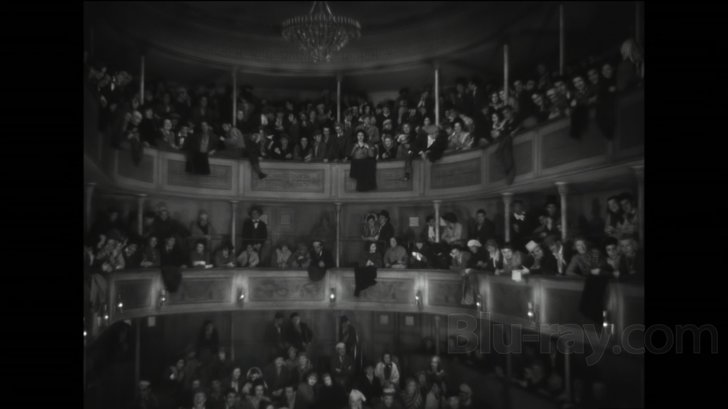
The only advice I could give to people interested in Pathe's new restoration of Marcel Carne's classic Children of Paradise is to find a way to rent Criterion's Blu-ray release before purchasing it. Some might be able to tolerate the filtering corrections that have been performed, but I couldn't. I don't feel comfortable speculating, but from what I saw, it appears that all of the work was done overseas, so there is virtually nothing that Criterion could have done to address some of the key issues. I think that this is a missed opportunity, especially considering the fact that the film was restored in 4K. RENT IT.
Similar titles
Similar titles you might also like

L' Atalante
1934

The Earrings of Madame de...
Madame de...
1953

The Rules of the Game 4K
La règle du jeu / 1959 Reconstructed Version
1939

Three Colors: Red
Trois couleurs: Rouge
1994

Orpheus
Orphée
1950

Betty Blue
37°2 le matin | Director's Cut
1986

Le silence de la mer
The Silence of the Sea
1949

Beauty and the Beast
La belle et la bête
1946

The Last Metro
Le dernier métro
1980

Jules and Jim
Jules et Jim
1962

A Woman Is a Woman
Une femme est une femme
1961

Babette's Feast
Babettes gæstebud
1987

Pierrot le fou
1965

Les visiteurs du soir
The Devil's Envoys
1942

Bastards
Les Salauds / Slipcover in Original Pressing
2013

The Red Shoes 4K
1948

Hiroshima mon amour
1959

Sarah's Key
Elle s'appelait Sarah
2010

Zéro de conduite
Zero for Conduct
1933

Vivre sa vie
Vivre sa vie: Film en douze tableaux / My Life to Live
1962
